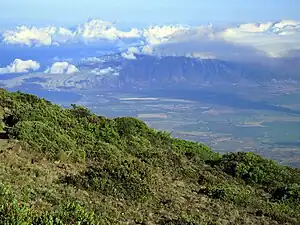The Hawaiian tropical high shrublands are a tropical savanna ecoregion in the Hawaiian Islands.
| Hawaiian tropical high shrublands | |
|---|---|
 | |
| Ecology | |
| Realm | Oceanian |
| Biome | Tropical and subtropical grasslands, savannas, and shrublands |
| Borders | |
| Geography | |
| Area | 1,900 km2 (730 sq mi) |
| Country | United States |
| State | Hawaii |
| Conservation | |
| Conservation status | Vulnerable[2] |
| Global 200 | No[3] |
Geography
The high shrublands ecoregion covers an area of 1,900 km2 (730 sq mi) on the upper slopes of the volcanoes Mauna Kea, Mauna Loa, Hualālai, and Haleakalā.
Flora
The plant communities include open shrublands, grasslands, and deserts. Shrubland species include ʻāheahea (Chenopodium oahuense), ʻōhelo ʻai (Vaccinium reticulatum), naʻenaʻe (Dubautia menziesii), and ʻiliahi (Santalum haleakalae). Alpine grasslands are dominated by tussock grasses, such as Deschampsia nubigena, Eragrostis atropioides, Panicum tenuifolium, and pili uka (Trisetum glomeratum). Deserts occur on the coldest and driest peaks, where only extremely hardy plants such as ʻāhinahina (Argyroxiphium sandwicense) and Dubautia species are able to grow.
Fauna
The nēnē (Branta sandvicensis) is one of the few birds found in alpine shrublands, while ʻuaʻu (Pterodroma sandwichensis) nest in this ecoregion.[2]
See also
References
- ↑ "Hawaii tropical high shrublands". Bioimages. Vanderbilt University. Retrieved 2011-11-19.
- 1 2 "Hawaii tropical high shrublands". Terrestrial Ecoregions. World Wildlife Fund. Retrieved 2011-11-19.
- ↑ Olson, David M.; Eric Dinerstein (2002). "The Global 200: Priority Ecoregions for Global Conservation" (PDF). Annals of the Missouri Botanical Garden. 89: 199–224. doi:10.2307/3298564.